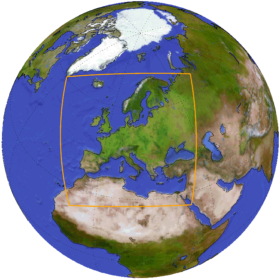Data and pairs of simulations
What is climate modelling?
Numerical climate models are used to project the possible future course of the climate system as well as to understand the climate system itself. They are built on mathematical descriptions of the governing physical processes of the climate system (eg, momentum, mass and conservation of energy, etc.).
General Circulation Models (GCMs) are global numerical climate models that are used to study global climate change. They describe various components of the Earth system and the nonlinear interactions and feedbacks between them. In order to simulate the past climate, the measured values of atmospheric composition (greenhouse gases, pollutants, anthropogenic aerosols) and land cover are used as forcing data, while for future projections, the values of socio-economic scenarios - economic particulars are used.
Due to the large number of data points and the high complexity of GCMs, their integration requires a large amount of computational resources. The resolution of their horizontal grid currently varies from 50 to 150 km and they provide an output with a temporal frequency of 6 hours. GCMs are therefore insufficient in many respects to estimate climate change and its variability at a finer scale.
A downscaling is therefore necessary to describe the local consequences of global change, which can be done through regional climate models (RCM). RCM integrations are typically run at 10-50 km horizontal resolution over a specific region of interest (eg over Europe in the case of EURO-CORDEX). Through a combination of explicit resolution of significant processes (e.g. mountain circulations, land-ocean contrasts) and parameterization schemes suitable for higher resolutions, RCMs are able to provide more detailed features of the climate. regional to local.
Climate simulations available in CANARI
Created in 2009, the EURO-CORDEX program is the European branch of the international project CORDEX (Coordinated Regional Downscaling Experiment), a program supported by the World Climate Research Program (WCRP) which aims to organize and coordinate an international production framework regional climate projections for all continental regions of the globe. EURO-CORDEX provides climate simulations based on both models using statistical and dynamic downscaling, forced by the global models used in the 5th IPCC report (CMIP5).

The climate simulations offered in CANARI all come from EURO-CORDEX. Each climate model has its own calculation
assumptions to represent the climate system. Thus, it is generally recommended by specialists to retain several
sets of simulations (from 5 to 6 different models) when using climate projections to explore the variability linked
to the different models.
In total, 6 pairs of GCMxRCM simulations were retained for the calculation of indicators in CANARI (see table below).
The choice of these different pairs is based in particular on the availability of corrected data (also called Cordex-adjust).
Thus, the simulation games selected come from various French, German, Swedish, Danish, etc. institutes.
| Domains | Regional Climate Models (RCM) | Driving Global Coupled Models (GCM) | ||
|---|---|---|---|---|
| MPI-M-MPI-ESM-LR (Germany) | ICHEC-EC-EARTH (Irland) | IPSL-IPSL-CM5A-MR (France) | ||
| EUR-11 | CCLM4-8-17 (ETH + BTU) EU | RCP 4.5 and 8.5 | RCP 4.5 and 8.5 | |
| RCA4 (SMHI) Sweden | RCP 4.5 and 8.5 | RCP 4.5 and 8.5 | ||
| RACMO22E (KNMI) Netherlands | RCP 4.5 and 8.5 | |||
| HIRHAM5 (DMI) Denmark | RCP 4.5 and 8.5 | |||
Characteristics of CANARI simulations
- Geographical resolution: all the simulations proposed correspond to the finest geographical resolution proposed by EURO-CORDEX (0.11 degrees, EUR-11), ie grid points of approximately 12.5 km on each side.
- Climate scenarios: two RCP (for Representative Concentration Pathway) scenarios are available, RCP4.5 (intermediate scenario), and scenario 8.5 (pessimistic scenario).
- Climatic variables: many climatic variables are available for each GCMxRCM couple. Systematically, the variables precipitation, minimum temperature, maximum temperature, average temperature and average wind speed are available. Other variables are only available randomly depending on the simulation game selected: specific humidity, relative humidity, maximum wind speed, radiation, etc.
- Available time period: for each of the modelling sets, the available time period is between 1985 and 2100.
- Time frequency: for each climatic variable, the data are daily.
Summary of simulations available in CANARI
| Simulation | Institution | GCM | RCM | Ensemble | Scenarios | Periode | Climate variables |
|---|---|---|---|---|---|---|---|
| Simulation 1 | CLMcom | MPI-M-MPI-ESM-LR | CCLM4-8-17 | r1i1p1 | RCP 4.5 and 8.5 | 1985 to 2100 | 12 |
| Simulation 2 | SMHI | ICHEC-EC-EARTH | RCA4 | r12i1p1 | 14 | ||
| Simulation 3 | CLMcom | ICHEC-EC-EARTH | CCLM4-8-17 | r12i1p1 | 12 | ||
| Simulation 4 | KNMI | ICHEC-EC-EARTH | RACMO22E | r1i1p1 | 13 | ||
| Simulation 5 | SMHI | IPSL-IPSL-CM5A-MR | RCA4 | r1i1p1 | 14 | ||
| Simulation 6 | DMI | ICHEC-EC-EARTH | KIRHAM5 | r3i1p1 | 13 |
CLMcom : CLM Community with contributions by BTU (Chair of Environmental Meteorology, Brandenburg University of Technology (BTU) Cottbus, Germany), DWD (German Weather Service), ETHZ (Swiss Federal Institute of Technology Zurich (ETH Zürich) ), UCD (Meteorology and Climate Centre, School of Mathematical Science, University College Dublin) WEGC (Wegener Center for Climate and Global Change, University of Graz, Austria)
DMI : Danish Meteorological Institute
KNMI : Royal Netherlands Meteorological Institute, Ministry of Infrastructure and the Environment
SMHI : Swedish Meteorological and Hydrological Institute
© 2026 Solagro - Makina Corpus - Legal notices - Contact us : canari@solagro.asso.fr